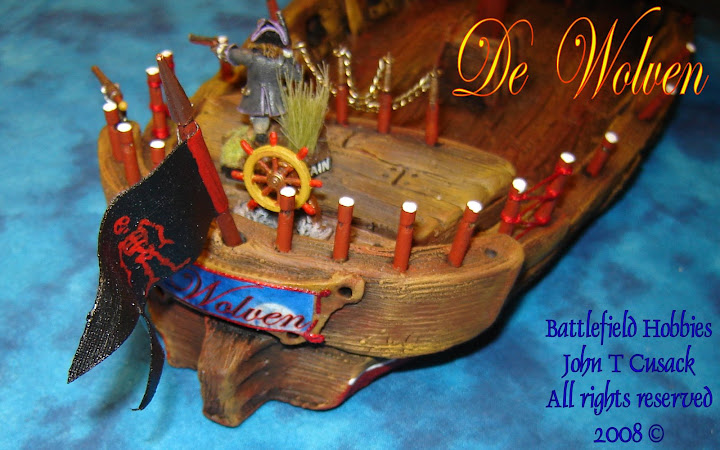 The Revenge is a 4-gun Ghost pirate ship, thus the dark blue and rather sinister glare of the young woman in blue. Creating Custom Artwork for you sail designs can be as simple as applying a stain to white canvas, or as complex as the design above for the Revenge.
The Revenge is a 4-gun Ghost pirate ship, thus the dark blue and rather sinister glare of the young woman in blue. Creating Custom Artwork for you sail designs can be as simple as applying a stain to white canvas, or as complex as the design above for the Revenge.The Black Heart
4-Gun Sloop sail artwork
The Harbinger
4-Gun Sloop sail artwork 
The Diamond Rose
6-Gun Topsail Schooner .JPG)
The Draco II
The Draco II
has two sail configurations, which changes the entire look of the ship. The Captain uses these two variations for very separate and distinct missions. Above we have a sail design with a Dragon design that is the Coat of Arms for the Captain. In this configuration, she is a vessel of commerce and her Captain takes the role of Privateer and Pirate Hunter. Notice the netting on the bow which covers the more sinister nature of the Draco.The Draco II
The Draco II, with her Pirate ship sail configuration. In this configuration the ship is transformed into her true nature, a predator of the seas. With the Ice dragon displayed upon her main sail, the Draco II is a ship to be feared. The netting on the bow and stern are removed to reveal the "teeth" of the dragon. For a close up view of the Ice Dragon stop by my Flickr page. Chaos on the Bayou is a Pirate gaming supplement, published by Battlefield Hobbies which introduces the Baron SaVoodie, and his minion Voodoo Zombies to the Pirates Code - Fast Play Rule system. This sail configuration has not yet been added to a ship, however the creation of the background for this sail is rather unique. Starting wit a white canvas, I have treated the surface with a Payne's grey, allowing the paint to pool on the surface. With pools of color on the canvas I had to allow it dry over night before beginning the next step. The Baron's image was then pulled from the color pools, withs shadows and highlights added. The natural discoloration on the canvas added to the effect. You will note the dark "stains" on the right side of the Baron's face, which had been pools of paint that dried to form blotches.
Chaos on the Bayou is a Pirate gaming supplement, published by Battlefield Hobbies which introduces the Baron SaVoodie, and his minion Voodoo Zombies to the Pirates Code - Fast Play Rule system. This sail configuration has not yet been added to a ship, however the creation of the background for this sail is rather unique. Starting wit a white canvas, I have treated the surface with a Payne's grey, allowing the paint to pool on the surface. With pools of color on the canvas I had to allow it dry over night before beginning the next step. The Baron's image was then pulled from the color pools, withs shadows and highlights added. The natural discoloration on the canvas added to the effect. You will note the dark "stains" on the right side of the Baron's face, which had been pools of paint that dried to form blotches.The Midnight Storm
8-Gun Brigantine
.JPG) The Midnight Storm is a more traditional pirate ship with clean lines and no frills. She is rigged with square sails, which are all furled. Notice the horizontal lines across the canvas. The lines on the Midnight Storm had been added after the canvas was colored a light Payne's grey by folding and creasing the canvas with the edge of an exacto knife. Each line is folded. then the flat edge of the blade is scraped across the canvas to form the line. This method can also be used prior to adding any color which I will explain below on the Spanish treasure ship.
The Midnight Storm is a more traditional pirate ship with clean lines and no frills. She is rigged with square sails, which are all furled. Notice the horizontal lines across the canvas. The lines on the Midnight Storm had been added after the canvas was colored a light Payne's grey by folding and creasing the canvas with the edge of an exacto knife. Each line is folded. then the flat edge of the blade is scraped across the canvas to form the line. This method can also be used prior to adding any color which I will explain below on the Spanish treasure ship. The Draco III is yet another variation of the dragon ship which as you my guess is rather popular. A full picture of this ship can be seen at the following site, Flickr
The Draco III is yet another variation of the dragon ship which as you my guess is rather popular. A full picture of this ship can be seen at the following site, Flickr Aslan is a small boat, with a single square sail configuration. The lion's head was painted directly upon the white canvas with the background added later. T see the complete boat stop by my Flickr page. The inspiration for this artwork is from the CS Lewis classic children's book, "The lion, the witch, and the wardrobe".
Aslan is a small boat, with a single square sail configuration. The lion's head was painted directly upon the white canvas with the background added later. T see the complete boat stop by my Flickr page. The inspiration for this artwork is from the CS Lewis classic children's book, "The lion, the witch, and the wardrobe"..JPG) The Java is a lateen rigged, or Latin-rigged ship. The latin-rig or triangular shaped sail was common in the Mediterranean Sea as found along the Barbary Coast, Red Seas and Indian ocean. This sail configuration is used on the Xebec, Dhows, Felucca or in the Modern Sunfish. The "coffee" colored stain was created with 1:4 paint to water mixture with folds already present before the mixture was applied to the canvas. The design was then added to the edge of the canvas with the same color as the water mixture, with a pen & ink style.
The Java is a lateen rigged, or Latin-rigged ship. The latin-rig or triangular shaped sail was common in the Mediterranean Sea as found along the Barbary Coast, Red Seas and Indian ocean. This sail configuration is used on the Xebec, Dhows, Felucca or in the Modern Sunfish. The "coffee" colored stain was created with 1:4 paint to water mixture with folds already present before the mixture was applied to the canvas. The design was then added to the edge of the canvas with the same color as the water mixture, with a pen & ink style.
The El Dorado is two mast Barque with four gun ports and an additional gun port on her bow which fires from the mouth of the great sea monster that looks forward always on the guard. The ship is latin-rigged (or Lateen rigged) with the triangular sails common on inter-coastal waters or rivers. The canvas was first treated with a Cadmium Yellow Deep Hue, with a touch of Burnt Sienna. The sail artwork then painted on the canvas with the skin color left
The United States Revenue Cutter (USRC) Louisiana

The USRC Louisiana is a two mast Schooner built as a pirate hunter, commissioned in service in 1819 along with her sister ship the USRC Alabama. The two had been responsible for the capture of the Pirate ship Bravo, Captained by Jean Lafarge. A know associate of the the infamous Jean Lafitte who gained his notoriety in the New Orleans area as a Privateer, freebooter, smuggler, patriot and pirate. The USRC are the ancestors of our modern day Coast Guard, the sentinels of our coastal waters, that risk their lives daily to keep our country safe.
The Phoenix De Oro
 The Phoenix De Oro is a treasure ship with vast holds and seven removable decks. Her two masts hold her amply sails. The white canvass was treated with regularly spaced folds, scratched into the canvas forming vertical lines on the sails. The sails had then balled up and vigorously crumpled up. This gives the sails random folds and creases, for the weather effect. Next a black wash is used to allow the black to darken the lines and creases on the canvas. The black wash is then cleaned off to avoid pooling of color. Once dry, the Spanish cross was added to the sails.
The Phoenix De Oro is a treasure ship with vast holds and seven removable decks. Her two masts hold her amply sails. The white canvass was treated with regularly spaced folds, scratched into the canvas forming vertical lines on the sails. The sails had then balled up and vigorously crumpled up. This gives the sails random folds and creases, for the weather effect. Next a black wash is used to allow the black to darken the lines and creases on the canvas. The black wash is then cleaned off to avoid pooling of color. Once dry, the Spanish cross was added to the sails.Conclusion: Using plain white canvas sails gives the your ship a historical look, while adding custom art work gives the ship a unique collectible value which can make your ships the center piece of the collection.

.JPG)





























